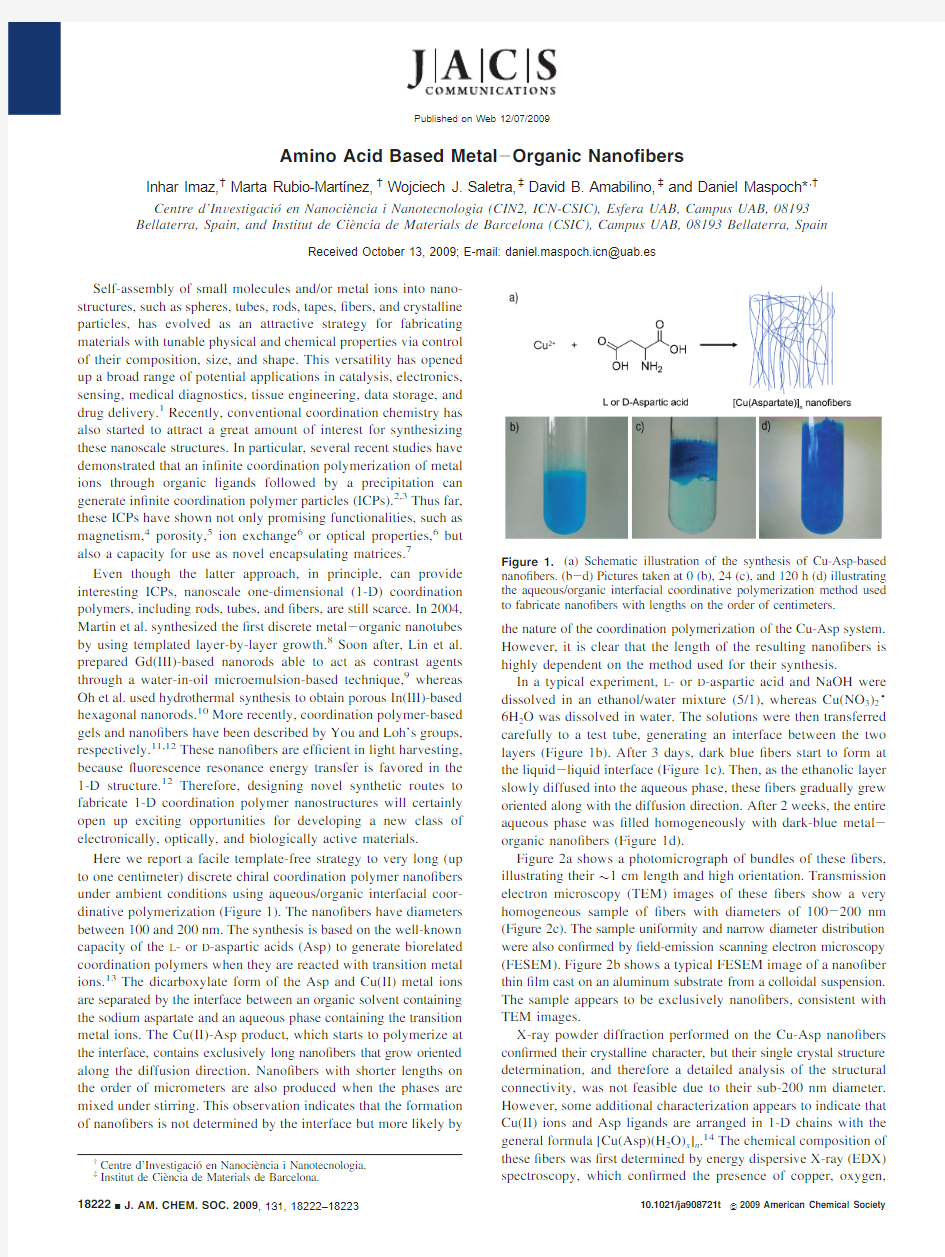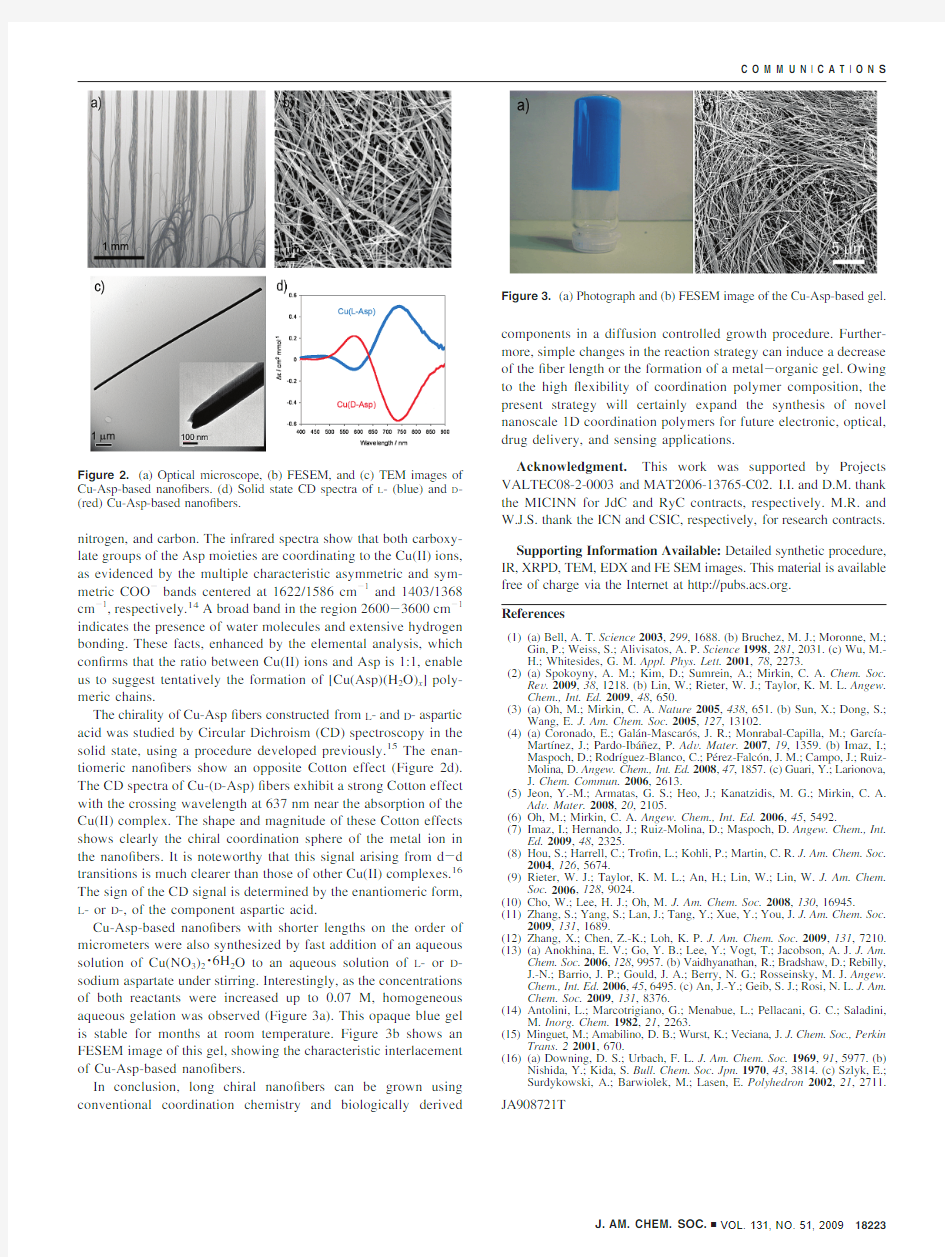Amino Acid Based Metal-OrganicNanofibers


Amino Acid Based Metal-Organic Nano?bers
Inhar Imaz,?Marta Rubio-Martínez,?Wojciech J.Saletra,?David B.Amabilino,?and Daniel Maspoch*,?
Centre d’In V estigacio′en Nanocie`ncia i Nanotecnologia(CIN2,ICN-CSIC),Esfera UAB,Campus UAB,08193 Bellaterra,Spain,and Institut de Cie`ncia de Materials de Barcelona(CSIC),Campus UAB,08193Bellaterra,Spain
Received October13,2009;E-mail:daniel.maspoch.icn@uab.es
Self-assembly of small molecules and/or metal ions into nano-
structures,such as spheres,tubes,rods,tapes,?bers,and crystalline
particles,has evolved as an attractive strategy for fabricating
materials with tunable physical and chemical properties via control
of their composition,size,and shape.This versatility has opened
up a broad range of potential applications in catalysis,electronics,
sensing,medical diagnostics,tissue engineering,data storage,and
drug delivery.1Recently,conventional coordination chemistry has
also started to attract a great amount of interest for synthesizing
these nanoscale structures.In particular,several recent studies have
demonstrated that an in?nite coordination polymerization of metal
ions through organic ligands followed by a precipitation can
generate in?nite coordination polymer particles(ICPs).2,3Thus far,
these ICPs have shown not only promising functionalities,such as
magnetism,4porosity,5ion exchange6or optical properties,6but
also a capacity for use as novel encapsulating matrices.7
Even though the latter approach,in principle,can provide
interesting ICPs,nanoscale one-dimensional(1-D)coordination
polymers,including rods,tubes,and?bers,are still scarce.In2004,
Martin et al.synthesized the?rst discrete metal-organic nanotubes by using templated layer-by-layer growth.8Soon after,Lin et al. prepared Gd(III)-based nanorods able to act as contrast agents through a water-in-oil microemulsion-based technique,9whereas Oh et https://www.360docs.net/doc/ef4681742.html,ed hydrothermal synthesis to obtain porous In(III)-based hexagonal nanorods.10More recently,coordination polymer-based gels and nano?bers have been described by You and Loh’s groups, respectively.11,12These nano?bers are ef?cient in light harvesting, because?uorescence resonance energy transfer is favored in the 1-D structure.12Therefore,designing novel synthetic routes to fabricate1-D coordination polymer nanostructures will certainly open up exciting opportunities for developing a new class of electronically,optically,and biologically active materials.
Here we report a facile template-free strategy to very long(up to one centimeter)discrete chiral coordination polymer nano?bers under ambient conditions using aqueous/organic interfacial coor-dinative polymerization(Figure1).The nano?bers have diameters between100and200nm.The synthesis is based on the well-known capacity of the L-or D-aspartic acids(Asp)to generate biorelated coordination polymers when they are reacted with transition metal ions.13The dicarboxylate form of the Asp and Cu(II)metal ions are separated by the interface between an organic solvent containing the sodium aspartate and an aqueous phase containing the transition metal ions.The Cu(II)-Asp product,which starts to polymerize at the interface,contains exclusively long nano?bers that grow oriented along the diffusion direction.Nano?bers with shorter lengths on the order of micrometers are also produced when the phases are mixed under stirring.This observation indicates that the formation of nano?bers is not determined by the interface but more likely by the nature of the coordination polymerization of the Cu-Asp system. However,it is clear that the length of the resulting nano?bers is highly dependent on the method used for their synthesis.
In a typical experiment,L-or D-aspartic acid and NaOH were dissolved in an ethanol/water mixture(5/1),whereas Cu(NO3)2·6H2O was dissolved in water.The solutions were then transferred carefully to a test tube,generating an interface between the two layers(Figure1b).After3days,dark blue?bers start to form at the liquid-liquid interface(Figure1c).Then,as the ethanolic layer slowly diffused into the aqueous phase,these?bers gradually grew oriented along with the diffusion direction.After2weeks,the entire aqueous phase was?lled homogeneously with dark-blue metal-organic nano?bers(Figure1d).
Figure2a shows a photomicrograph of bundles of these?bers, illustrating their~1cm length and high orientation.Transmission electron microscopy(TEM)images of these?bers show a very homogeneous sample of?bers with diameters of100-200nm (Figure2c).The sample uniformity and narrow diameter distribution were also con?rmed by?eld-emission scanning electron microscopy (FESEM).Figure2b shows a typical FESEM image of a nano?ber thin?lm cast on an aluminum substrate from a colloidal suspension. The sample appears to be exclusively nano?bers,consistent with TEM images.
X-ray powder diffraction performed on the Cu-Asp nano?bers con?rmed their crystalline character,but their single crystal structure determination,and therefore a detailed analysis of the structural connectivity,was not feasible due to their sub-200nm diameter. However,some additional characterization appears to indicate that Cu(II)ions and Asp ligands are arranged in1-D chains with the general formula[Cu(Asp)(H2O)x]n.14The chemical composition of these?bers was?rst determined by energy dispersive X-ray(EDX) spectroscopy,which con?rmed the presence of copper,oxygen,
?Centre d’Investigacio′en Nanocie`ncia i Nanotecnologia.?Institut de Cie`ncia de Materials de
Barcelona.Figure1.(a)Schematic illustration of the synthesis of Cu-Asp-based nano?bers.(b-d)Pictures taken at0(b),24(c),and120h(d)illustrating the aqueous/organic interfacial coordinative polymerization method used to fabricate nano?bers with lengths on the order of
centimeters.
Published on Web12/07/2009
10.1021/ja908721t 2009American Chemical Society 182229J.AM.CHEM.SOC.2009,131,18222–18223
nitrogen,and carbon.The infrared spectra show that both carboxy-late groups of the Asp moieties are coordinating to the Cu(II)ions,as evidenced by the multiple characteristic asymmetric and sym-metric COO -bands centered at 1622/1586cm -1and 1403/1368cm -1,respectively.14A broad band in the region 2600-3600cm -1indicates the presence of water molecules and extensive hydrogen bonding.These facts,enhanced by the elemental analysis,which con?rms that the ratio between Cu(II)ions and Asp is 1:1,enable us to suggest tentatively the formation of [Cu(Asp)(H 2O)x ]poly-meric chains.
The chirality of Cu-Asp ?bers constructed from L -and D -aspartic acid was studied by Circular Dichroism (CD)spectroscopy in the solid state,using a procedure developed previously.15The enan-tiomeric nano?bers show an opposite Cotton effect (Figure 2d).The CD spectra of Cu-(D -Asp)?bers exhibit a strong Cotton effect with the crossing wavelength at 637nm near the absorption of the Cu(II)complex.The shape and magnitude of these Cotton effects shows clearly the chiral coordination sphere of the metal ion in the nano?bers.It is noteworthy that this signal arising from d -d transitions is much clearer than those of other Cu(II)complexes.16The sign of the CD signal is determined by the enantiomeric form,L -or D -,of the component aspartic acid.
Cu-Asp-based nano?bers with shorter lengths on the order of micrometers were also synthesized by fast addition of an aqueous solution of Cu(NO 3)2·6H 2O to an aqueous solution of L -or D -sodium aspartate under stirring.Interestingly,as the concentrations of both reactants were increased up to 0.07M,homogeneous aqueous gelation was observed (Figure 3a).This opaque blue gel is stable for months at room temperature.Figure 3b shows an FESEM image of this gel,showing the characteristic interlacement of Cu-Asp-based nano?bers.
In conclusion,long chiral nano?bers can be grown using conventional coordination chemistry and biologically derived
components in a diffusion controlled growth procedure.Further-more,simple changes in the reaction strategy can induce a decrease of the ?ber length or the formation of a metal -organic gel.Owing to the high ?exibility of coordination polymer composition,the present strategy will certainly expand the synthesis of novel nanoscale 1D coordination polymers for future electronic,optical,drug delivery,and sensing applications.
Acknowledgment.This work was supported by Projects VALTEC08-2-0003and MAT2006-13765-C02.I.I.and D.M.thank the MICINN for JdC and RyC contracts,respectively.M.R.and W.J.S.thank the ICN and CSIC,respectively,for research contracts.
Supporting Information Available:Detailed synthetic procedure,IR,XRPD,TEM,EDX and FE SEM images.This material is available free of charge via the Internet at https://www.360docs.net/doc/ef4681742.html,.References
(1)(a)Bell,A.T.Science 2003,299,1688.(b)Bruchez,M.J.;Moronne,M.;
Gin,P.;Weiss,S.;Alivisatos,A.P.Science 1998,281,2031.(c)Wu,M.-H.;Whitesides,G.M.Appl.Phys.Lett.2001,78,2273.
(2)(a)Spokoyny,A.M.;Kim,D.;Sumrein,A.;Mirkin,C.A.Chem.Soc.
Re V .2009,38,1218.(b)Lin,W.;Rieter,W.J.;Taylor,K.M.L.Angew.Chem.,Int.Ed.2009,48,650.
(3)(a)Oh,M.;Mirkin,C.A.Nature 2005,438,651.(b)Sun,X.;Dong,S.;
Wang,E.J.Am.Chem.Soc.2005,127,13102.(4)(a)Coronado,E.;Gala ′n-Mascaro ′s,J.R.;Monrabal-Capilla,M.;Garc?′a-Mart?′nez,J.;Pardo-Iba ′n ?ez,P.Ad V .Mater.2007,19,1359.(b)Imaz,I.;
Maspoch,D.;Rodr?′guez-Blanco,C.;Pe ′rez-Falco ′n,J.M.;Campo,J.;Ruiz-Molina,D.Angew.Chem.,Int.Ed.2008,47,1857.(c)Guari,Y.;Larionova,https://www.360docs.net/doc/ef4681742.html,mun.2006,2613.
(5)Jeon,Y.-M.;Armatas,G.S.;Heo,J.;Kanatzidis,M.G.;Mirkin,C.A.
Ad V .Mater.2008,20,2105.
(6)Oh,M.;Mirkin,C.A.Angew.Chem.,Int.Ed.2006,45,5492.
(7)Imaz,I.;Hernando,J.;Ruiz-Molina,D.;Maspoch,D.Angew.Chem.,Int.
Ed.2009,48,2325.
(8)Hou,S.;Harrell,C.;Tro?n,L.;Kohli,P.;Martin,C.R.J.Am.Chem.Soc.
2004,126,5674.
(9)Rieter,W.J.;Taylor,K.M.L.;An,H.;Lin,W.;Lin,W.J.Am.Chem.
Soc.2006,128,9024.
(10)Cho,W.;Lee,H.J.;Oh,M.J.Am.Chem.Soc.2008,130,16945.
(11)Zhang,S.;Yang,S.;Lan,J.;Tang,Y.;Xue,Y.;You,J.J.Am.Chem.Soc.
2009,131,1689.
(12)Zhang,X.;Chen,Z.-K.;Loh,K.P.J.Am.Chem.Soc.2009,131,7210.(13)(a)Anokhina,E.V.;Go,Y.B.;Lee,Y.;Vogt,T.;Jacobson,A.J.J.Am.
Chem.Soc.2006,128,9957.(b)Vaidhyanathan,R.;Bradshaw,D.;Rebilly,J.-N.;Barrio,J.P.;Gould,J.A.;Berry,N.G.;Rosseinsky,M.J.Angew.Chem.,Int.Ed.2006,45,6495.(c)An,J.-Y.;Geib,S.J.;Rosi,N.L.J.Am.Chem.Soc.2009,131,8376.
(14)Antolini,L.;Marcotrigiano,G.;Menabue,L.;Pellacani,G.C.;Saladini,
M.Inorg.Chem.1982,21,2263.
(15)Minguet,M.;Amabilino,D.B.;Wurst,K.;Veciana,J.J.Chem.Soc.,Perkin
Trans.22001,670.
(16)(a)Downing,D.S.;Urbach,F.L.J.Am.Chem.Soc.1969,91,5977.(b)
Nishida,Y.;Kida,S.Bull.Chem.Soc.Jpn.1970,43,3814.(c)Szlyk,E.;Surdykowski,A.;Barwiolek,M.;Lasen,E.Polyhedron 2002,21,2711.
JA908721T
Figure 2.(a)Optical microscope,(b)FESEM,and (c)TEM images of
Cu-Asp-based nano?bers.(d)Solid state CD spectra of L -(blue)and D -(red)Cu-Asp-based
nano?bers.
Figure 3.(a)Photograph and (b)FESEM image of the Cu-Asp-based gel.
J.AM.CHEM.SOC.
9
VOL.131,NO.51,200918223
C O M M U N I C A T I O N S
